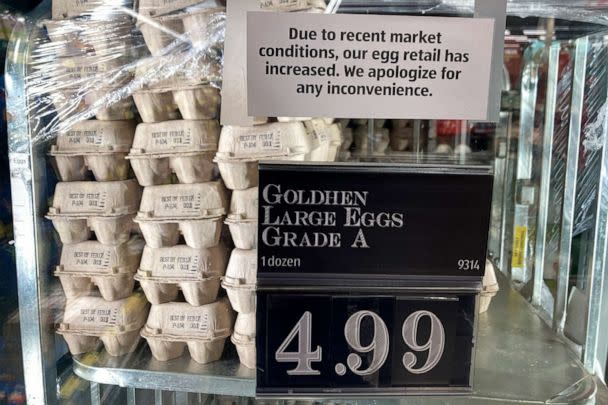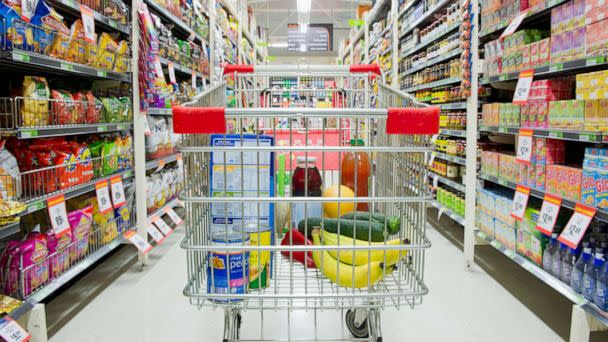12 grocery, food savings tips to take on your next shopping trip amid rising costs
Consumer prices are up 6.5% compared to a year ago and although inflation has fallen since it's 9.1% peak in June, shoppers still need ways to save, especially on groceries.
Despite inflation falling for the sixth consecutive month, it continues to hover near a 40-year high with food prices jumping .3% higher in December.
Last October, food prices reached the largest annual increase of 11.2% in over four decades since 1981, according to the U.S. Bureau of Labor Statistics. Now, the "food at home" category -- grocery store food products purchased for cooking or eating at home -- is currently up 11.8% over the last 12-month period.
The overall food category, which includes both at-home as well as restaurants and takeout, increased 10.4% in the last year.
The current price of a carton of eggs is nearly 11.1% higher than where it was a year ago and other major grocery store food groups posted increases ranging from 7.7% -- meats, poultry, fish, and eggs -- to 15.3% on dairy and related products.
Trae Bodge, smart shopping expert, shared her tips for saving on groceries with "Good Morning America," to help consumers keep costs down at checkout.
Top tips to stay on a budget in the grocery store
Eat vegetarian
"You might find that poultry, meats, and fish have increased more in price than vegetables and other items, like rice and pasta," Bodge said. "If that's the case in your area, you could save a bundle by eating [vegetarian meals] a couple of nights a week."
MORE: Here's which food items might be more expensive at the grocery store this month
Use coupon sites to save
"You might think of coupon sites for clothing and tech, but not for food, when in fact coupon sites like CouponCabin.com have offers for grocery delivery, like $25 off $35 or more at Instacart or $55 off $99 or more," she said of the simple at-your-fingertips savings option.

Don't buy pre-cut produce
Buy fruits and vegetables whole and prepare them at home. "You're paying for labor when you buy pre-cut," she explained.
Look low and high on store shelves
"You're more likely to find better deals on the lowest and highest shelves. Brands pay for prime real estate at eye level, but there are hidden gems in less visible spots," Bodge suggested.
Read between the price tags
"You can determine whether or not an item is a good deal by comparing the cost-per-unit rather than the actual price," she said, explaining that the sticker price doesn't always reflect the total value.
Look out for "shrinkflation"
"Many brands are shrinking the size or weight of their products and charging the same price," Bodge said, adding that shoppers should always check the unit prices when selecting items.

Join loyalty programs
Bodge advised using rewards programs -- sticking to the stores where you shop most often -- which may "offer a free way to earn points towards future purchases."
"They offer exclusive deals and some will even allow you to qualify for free things, like a free turkey at Thanksgiving or a free gas card," she said.
MORE: New Grubhub perk for Amazon Prime members
Credit cards with grocery perks
"Using the right credit card to buy your groceries could earn you some serious cash back. Cards with annual fees typically have more generous cash-back [offers], like 4% or more on food from American Express Gold, but there are some fee-free cards that offer this, including the Bread Cashback American Express from Bread Financial, which offers 2% cashback on all purchases," she said. "Another good fee-free card is the Amazon Prime Rewards Visa, which allows you to earn 5% on Amazon and Whole Foods purchases."
Smart and easy swaps to save even more
Buy frozen
"In certain cases," Bodge said, this tactic "can be a big money-saver."
"I find this especially with fish and certain vegetables," she added. "Plus, frozen has a longer shelf life."
Buy generic
"You can save 20% or more by doing this and you'll find that many of the ingredient listings match the brand name word for word," Bodge said. "In fact, store brands or generics are often made in the same factories as the name brand."
Buy seasonal produce

"You will do much better on price, versus buying things that need to be imported," Bodge said. "Also, check out your local CSA -- community-supported agriculture is a food system for farmers and producers to connect directly with consumers. This is a great way to support local farmers and the pricing is often very good."
Bodge, however, recommended against "buying at farmers markets if you're on a tight budget."
Only buy in bulk on most-used items
"If there are certain items that you go through quickly, like toilet paper, pastas, canned goods or snacks for your kids' lunches, buy them in bulk if you have a Costco or Sam's Club membership," Bodge suggested. "You can also often buy in bulk on Amazon and on a site like Boxed.com."
12 grocery, food savings tips to take on your next shopping trip amid rising costs originally appeared on goodmorningamerica.com
